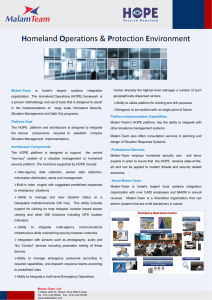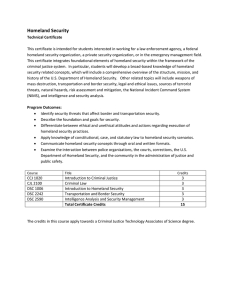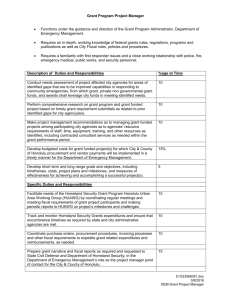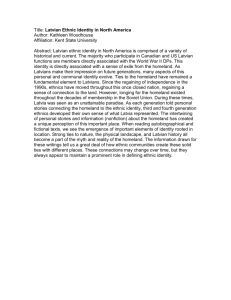Ray Nelson Executive Director
advertisement
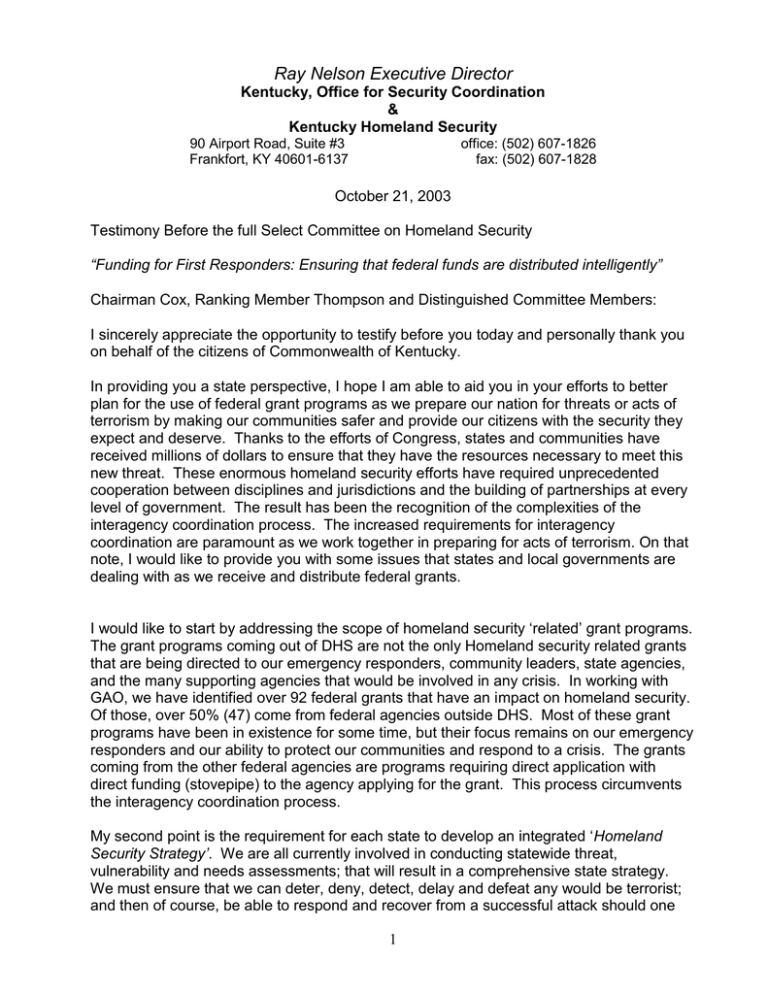
Ray Nelson Executive Director Kentucky, Office for Security Coordination & Kentucky Homeland Security 90 Airport Road, Suite #3 Frankfort, KY 40601-6137 office: (502) 607-1826 fax: (502) 607-1828 October 21, 2003 Testimony Before the full Select Committee on Homeland Security “Funding for First Responders: Ensuring that federal funds are distributed intelligently” Chairman Cox, Ranking Member Thompson and Distinguished Committee Members: I sincerely appreciate the opportunity to testify before you today and personally thank you on behalf of the citizens of Commonwealth of Kentucky. In providing you a state perspective, I hope I am able to aid you in your efforts to better plan for the use of federal grant programs as we prepare our nation for threats or acts of terrorism by making our communities safer and provide our citizens with the security they expect and deserve. Thanks to the efforts of Congress, states and communities have received millions of dollars to ensure that they have the resources necessary to meet this new threat. These enormous homeland security efforts have required unprecedented cooperation between disciplines and jurisdictions and the building of partnerships at every level of government. The result has been the recognition of the complexities of the interagency coordination process. The increased requirements for interagency coordination are paramount as we work together in preparing for acts of terrorism. On that note, I would like to provide you with some issues that states and local governments are dealing with as we receive and distribute federal grants. I would like to start by addressing the scope of homeland security ‘related’ grant programs. The grant programs coming out of DHS are not the only Homeland security related grants that are being directed to our emergency responders, community leaders, state agencies, and the many supporting agencies that would be involved in any crisis. In working with GAO, we have identified over 92 federal grants that have an impact on homeland security. Of those, over 50% (47) come from federal agencies outside DHS. Most of these grant programs have been in existence for some time, but their focus remains on our emergency responders and our ability to protect our communities and respond to a crisis. The grants coming from the other federal agencies are programs requiring direct application with direct funding (stovepipe) to the agency applying for the grant. This process circumvents the interagency coordination process. My second point is the requirement for each state to develop an integrated ‘Homeland Security Strategy’. We are all currently involved in conducting statewide threat, vulnerability and needs assessments; that will result in a comprehensive state strategy. We must ensure that we can deter, deny, detect, delay and defeat any would be terrorist; and then of course, be able to respond and recover from a successful attack should one 1 occur. Our strategy will undoubtedly focus on a regional approach, to ensure that we maintain, and sustain, a base-capability and capacity statewide, as well as maintaining our focus on population centers, critical infrastructure and the actual threat. As you can see, this approach cannot be accomplished working in a vacuum or through a stovepipe funding process. My third point today is to remember that development of a strategy and capabilities is only the beginning – sustainment of these efforts will be the challenge. States need to have assurances of baseline federal funding that will fund these initiatives for the long term. With limited shelf-life of equipment, improvements in technology and training upgrades, states will need consistent and predictable funding. This brings me to the focal point of my comments here today. We must develop, and enforce, a federal, state and local government interagency coordination process as it relates to federal homeland security grant programs. To effectively orchestrate a federal, state or local jurisdiction homeland security strategy, requires that all affected agencies coordinate to maximize the efforts and effects of current federal grant programs. The outcome of our efforts will depend upon the state’s ability to build comprehensive and integrated plans at the state and local level. We can no longer afford to allow organizations to operate as autonomous entities and plan in a vacuum. As an example, the interoperability problems we face today are a direct result of a lack of interagency coordination. As states, we recognize our role and responsibility and are moving rapidly to ensure we take the steps necessary to develop and sustain our capabilities. As a nation, we can only be secure when every community in every county in every state is secure. Therefore, if our states, in particular our governors, are to be held responsible and accountable for the safety and security of our citizens, all federal grant programs that affect our emergency responders, or the multitude of agencies supporting their efforts, must be coordinated through the governor’s office. As the state’s homeland security coordinator, I frequently ‘discover’ additional homeland security grant programs coming from federal agencies; whether it is for school terrorism planning, agri-terrorism, inter-city bus security programs or eco-terrorism; by reading the local newspaper. This is not the most effective way of doing business. Having said this, I must complement the Department of Homeland Security in their efforts to coordinate all federal grant programs coming from the new department. However, there are numerous other federal agencies that have not embraced the necessity for interagency coordination at the federal, state and local levels. My final point is that to ensure the effective use of taxpayer’s dollars, we must measure effectiveness, efficiencies, performance and compliance, in the expenditure of these funds. Without mandated coordination, performance and compliance measures, we will be no better off five years from now, than we were on 10 September 2001. In the words of professor Albert Einstein, “Today’s problems cannot be solved with yesterday’s thinking”. This is no longer business as usual. We must coordinate all Homeland Security ‘related’ Grant Programs throughout the federal government to allow a fully coordinated 2 implementation by the States, counties and cities. There is only one strategy and all initiatives should support this statewide strategy. In closing, I would like to reiterate that each and every day our communities become more secure and our first responders better prepared. Achieving our goal to make our homeland secure will take time. This is a team effort and states are committed to being a team player. We need the resources to meet this challenge, but please don’t tie our hands. Give us the flexibility and tools help us do our job better. I appreciate this opportunity and will be glad to answer any questions you may have. 3 This diagram reflects how federal homeland security related grants are coming into KY. 4 Generic Federal Grant process flowchart Announcement of Grant Availability FEDERAL GRANTOR 1. Application for Grant award 2. Grant Award 3. SOW & detailed line item grant budget 4. Approved SOW & detailed grant budget 8. Request for Federal cash reimbursement 9. Drawdown of federal cash STATE AGENCY GRANTEE Appropriated funding** 5. Contractual Grant agreements 7. 6. Reimbursement Request check for Actual Cost Reimbursement LRC Contract Review subcommittee Sub-Grantee / Sub-recipient / Vendor ** coordination with GOPM and A&R on DMA appropriations Eligible $ expense Kentucky Security Homeland Security Kentucky Homeland This diagram reflects the federal grant process. This process needs to be simplified and standardized. 5 This diagram depicts the manner in which federal homeland security related grants “should’ be coming into KY. 6

